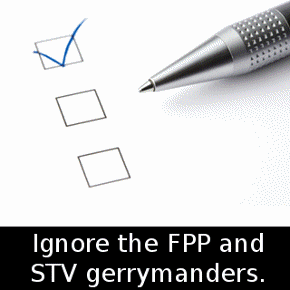More on the MMP referenda
It will be interesting to see the next stage of Cabinets plans for the two stage referenda on the electoral system. The first stage, at the 2011 election, asks whether we should change our electoral system, the next stage provides options for change should change be desired. How many options? We don't know. And nothing will change until at least 2017.
Now I think I have this right. Take this scenario, which appears to be the way Cabinet is heading. Let's say the first referendum gets a 45/55 split with 55 percent supporting a change of electoral system.This was the split that led to the introduction of MMP in 1986. Significantly the 45 percent minority would prefer the retention of MMP than change to another electoral system. But lets say the second stage has a run off between three electoral systems - say if 35 percent vote STV, 25 percent vote SM, 40 percent vote FPP, then FPP would be the electoral system, right?
Wrong. MMP would. Despite more than 50 percent initially voting for a change from MMP. A referendum needs more than a 50 percent vote for a specified electoral system to be changed.
In the first referendum 45% wanted to keep MMP which is higher than the numbers that voted for the highest polling electoral system in the second stage. Not one voting block got over 50%, so that will be a complete waste of money. Even if MMP was one of the options in the latter referendum, as Graeme Edgeler notes, MMP will be the declared electoral system even if it got the smallest proportion of the vote, if no other system got over over 50 percent of the vote.
That would also be the wrong way to go about this*. It just won't work. MMP supporter David Farrar suggests the first referendum be done in two parts. The first part will ask if we should change our electoral system, the second part which system we would change it to should changed be desired, with the most popular option being run off in the second referendum at the following election.
So, on the above figures, if the first 2011 referendum combined the above two stages,in 2014 there could be a be a referendum between several electoral systems. Unless that referendum was conducted under STV rules*, on the above figures this will be either MMP v FPP(the current system and top alternative) or FPP v STV(the two favoured alternatives). If it was to be the latter, 45 percent of the population will be unhappy as their preferred option was MMP. If it was MMP v FPP, it will technically be a rehash of the first referendum, the only difference being which of the 55 percent that wanted change would support FPP, assuming all the 45 percent who voted against change still support MMP. Some of the 55 percent may have wanted a change to STV. If enough that did voted for MMP because they wanted at least some proportionality, the current system would be retained.
So there has to be two questions at the first referenda. In the second referenda, an electoral system other than MMP must have 50 percent of the vote for an electoral system change - and the more options there are the less likely that will happen. But if the Government follows this format, some people are not going to be able to vote for their favoured electoral system after being asked what their preference was in the second stage of the first referenda.
*unless the second referendum was conducted by ranking ala STV rules -which it looks like it can't be unless they first pass a regulation.
Labels: electoral systems, MMP




1 Comments:
The Electoral Referendum was a one-off act. It can't be used for the next referendum - they'll need a new law anyway.
Post a Comment
Subscribe to Post Comments [Atom]
<< Home